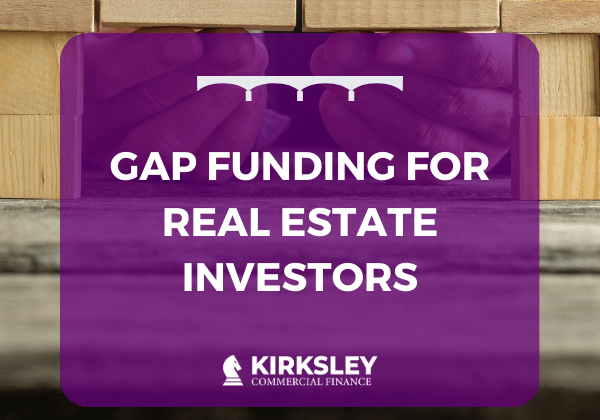Gap Funding for Real Estate Investors

Gap funding can accelerate your activity as a real estate investor (but use it wisely)
If you're a property flipper in the real estate market, you're aware of the substantial capital required for purchasing and renovating properties. The challenge of securing these funds often acts as a stumbling block, hindering many investors from realizing their real estate dreams. This is where gap funding comes into play. As a lesser-known but potentially effective real estate financing tool, gap funding can help investors bridge the gap between their available funds and the total amount needed for their investment projects.
What to Know About Gap Funding for Real Estate
Gap funding, or down payment assistance, is a specialized financial tool crafted to help investors with the capital demands of real estate projects. It provides the funds necessary to bridge the gap between the investor's existing capital and the total costs associated with their investment. This short-term financing option is often a go-to resource when an investor requires immediate access to funds. It is usually used in combination with a hard money loan for a rehab project. The beauty of gap funding lies in its versatility, covering a plethora of expenses, from down payments and renovation expenditures to closing costs. Therefore, understanding how to access this funding for real estate investors can provide financial agility.
The Role of This Form of Financing in Real Estate Investing
As a potential facilitator for real estate investors, gap funding can be used in conjunction with a purchase and rehab loan from a hard money lender. Its role becomes essential when investors may not be able to supply all the capital required to close a real estate loan. By filling the monetary chasm with gap funding, investors gain the leverage to augment their profits, expand their investment horizons, and finalize deals that may otherwise remain off-limits. Essentially, this form of funding provides an avenue for not only surviving but thriving in the dynamic and often unpredictable world of property investing.
How to Get Down Payment Financing with Gap Funding
Beginning the journey towards gap funding calls for a methodical approach by the investor. Initially, identifying a profitable real estate deal is vital. It's imperative to conduct a thorough cost evaluation, accounting for all foreseeable expenses including acquisition and renovation. Identify how much of the purchase cost can be financed with a hard money loan. The down payment requirement may be what you need for gap funding. The next stage is to explore potential sources of gap funding, including private lenders, business credit acquisition companies, or specific real estate investment loans from financial institutions. Each lender comes with distinct requirements, repayment structures, and interest rates, underlining the necessity for good research and comparison before proceeding.
Navigating the Risks - Use Gap Funding Wisely as a Smart Real Estate Investor
Every financial solution has inherent risks, and gap funding is no different. Gap funding should be used with real caution. A primary concern is the potential for elevated interest rates due to the short-term nature of these loans. Additionally, uncertainties in property valuation or delays in sales can pose repayment challenges. Minimizing these risks calls for a robust plan to handle the mortgage and the gap funding load, a clear exit/repayment strategy in 6-9 months, and viable contingency measures. Ensure you only borrow an amount that aligns with your repayment capacity, and it is paramount to comprehend every detail of your funding agreement. Finally, only use gap funding with a short-term bridge loan where a sale or refinance of the property will produce a cash return to pay off the gap funding agreement. Gap funding isn't suitable for a down payment on the purchase of a rental property with long-term financing. You won't be able to pay off the gap financing in the required 6-9 months with simple monthly rental income.
Finding the Business Credit Solutions That Do Not Report to Personal Credit
Maintaining a clear distinction between your personal and business finances is critical, especially when it comes to securing credit. You should run your real estate investments as a real business. Thus, one effective approach involves seeking out business credit solutions that won't report to your personal credit. This strategy safeguards your personal credit score from potential fluctuations due to business operations. Furthermore, it fosters the creation of an independent business credit profile. A solid business credit history not only boosts your business's reputation but can also broaden its capacity to borrow. Finally, be aware that attractive offers such as 0% interest business credit card options may be available (for a 6-month or 12-month term usually). Be absolutely certain you will pay off the funding before the no interest period expires to avoid heavy interest charges. Thus, this "credit card stacking" approach can form a useful part of your wider real estate strategy.
Why Professionalism is Key in Real Estate Gap Funding
When assessing gap funding lenders, look for experience and integrity with the gap lender. The same applies for the borrower. Rigorous property assessments, open and concise communication with lenders, and a proven track record of timely repayments all illustrate your commitment to professionalism. These qualities can significantly enhance your credibility in the eyes of lenders, making them more likely to offer better financing terms and support your future investment endeavors. Remember, professionalism in real estate investing not only enhances your reputation but also broadens your access to more funding options. Stay diligent, stay transparent, and watch your investment journey flourish.

Ryan Stuckey
- Kirksley Commercial Finance
- Belcanto Capital
- Longhorn Investments
- Fix and Flip Financing
- Hard Money Methods
Subscribe to email
SIGN UP - KEEP IN TOUCH
Stay connected with Kirksley Commercial Finance




